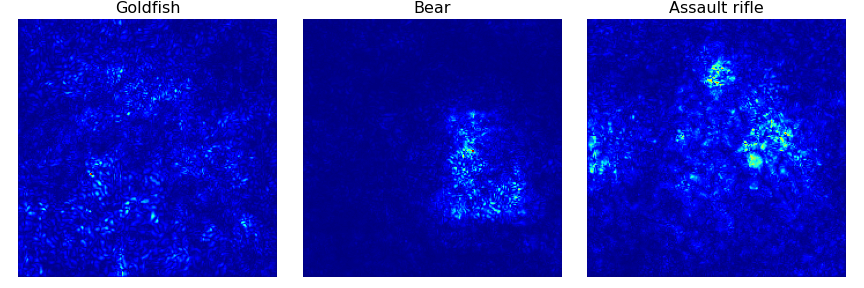Vanilla Saliency and SmoothGrad
Vanilla Saliency

SmoothGrad

- class tf_keras_vis.saliency.Saliency(model, model_modifier=None, clone=True)[source]
Bases:
ModelVisualizationVanilla Saliency and Smooth-Grad
References
Vanilla Saliency: Deep Inside Convolutional Networks: Visualising Image Classification Models and Saliency Maps (https://arxiv.org/pdf/1312.6034)
SmoothGrad: removing noise by adding noise (https://arxiv.org/pdf/1706.03825)
- Parameters:
model – A keras.Model instance. When model_modifier is NOT None, this model will be cloned with keras.models.clone_model function and then will be modified by model_modifier according to needs.
model_modifier – A
tf_keras_vis.utils.model_modifiers.ModelModifierinstance, a function or a list of them. We recommend to apply tf_keras_vis.utils.model_modifiers.ReplaceToLinear to all visualizations (excepttf_keras_vis.scorecam.Scorecam) when the model output is softmax. Defaults to None.clone – A bool that indicates whether or not it clones the model. When False, the model won’t be cloned. Note that, although when True, the model won’t be clone if model_modifier is None. Defaults to True.
- __call__(score, seed_input, smooth_samples=0, smooth_noise=0.20, keepdims=False, gradient_modifier=lambda grads: ..., training=False, normalize_map=True, unconnected_gradients=tf.UnconnectedGradients.NONE)[source]
Generate an attention map that appears how output value changes with respect to a small change in input image pixels.
- Parameters:
score –
A
tf_keras_vis.utils.scores.Scoreinstance, function or a list of them. For example of the Score instance to specify visualizing target:scores = CategoricalScore([1, 294, 413])
The code above means the same with the one below:
score = lambda outputs: (outputs[0][1], outputs[1][294], outputs[2][413])
When the model has multiple outputs, you MUST pass a list of Score instances or functions. For example:
from tf_keras_vis.utils.scores import CategoricalScore, InactiveScore score = [ CategoricalScore([1, 23]), # For 1st model output InactiveScore(), # For 2nd model output ... ]
seed_input – A tf.Tensor,
numpy.ndarrayor a list of them to input in the model. That’s when the model has multiple inputs, you MUST pass a list of tensors.smooth_samples (int, optional) – The number of calculating gradients iterations. When over zero, this method will work as SmoothGrad. When zero, it will work as Vanilla Saliency. Defaults to 0.
smooth_noise – Noise level. Defaults to 0.20.
keepdims – A bool that indicates whether or not to keep the channels-dimension. Defaults to False.
gradient_modifier – A function to modify gradients. Defaults to None.
training – A bool that indicates whether the model’s training-mode on or off. Defaults to False.
normalize_map (bool, optional) – When True, saliency map will be normalized. Defaults to True.
unconnected_gradients – Specifies the gradient value returned when the given input tensors are unconnected. Defaults to tf.UnconnectedGradients.NONE.
- Returns:
An
numpy.ndarrayor a list of them. They are the saliency maps that indicate the seed_input regions whose change would most contribute the score value.- Raises:
ValueError – When there is any invalid arguments.
- Return type: